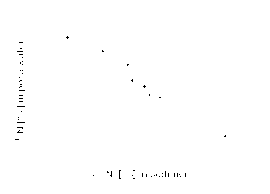
Lake Bled is a small subalpine lake located in NW Slovenia. It is highly eutrophic. However, due to intense restoration measures which include a pipe line that introduces river water into the lake and removes anoxic hypolimnical water, ecological conditions are improving. A stable isotope study of carbon and nitrogen was used to follow the decomposition of organic matter at and below the sediment/water interface and to estimate the equilibria of the carbonate system in the pore water.
The isotopic analysis of C and O in total carbonate showed that a significant amount of detritic carbonate is present in the sediment close to the shore, whereas in deeper parts of the lake autigenic carbonate phases prevail. d13C of sedimentary organic carbon (SOC) varies widely (between -27 and -38”PDB) and increases regularly with the depth. The primary source of SOC are phyto- and zooplankton, showing typical d13C values between -15 and -26”, the isotopic composition of carbon in water plants varies between -11 and -26” and leaves of the nearby trees between -27 and -30”, so the sediment is significantly depleted with 13C with respect to it's source, a fact that can not be explained by mineralization. Therefore we assume that bacterial populations and adsorbed higher hydrocarbons in the sediment are lowering the total d13C of SOC (Freeman et al., 1990). Dissolved organic carbon (DOC) in pore water shows d13C values between -26 and -29”, corresponding to those of SOC. Detailed analysis showed that there exists a correlation between the concentration of dissolved inorganic carbon (DIC, calculated from total alkalinity (Millero, 1995)), isotopic composition of C in organic matter and the d13C of carbonate. To estimate whether organic carbon can be a source of CO2 for the precipitation of carbonates, we calculated the saturation indices for carbonate minerals (calcite, dolomite, aragonite). It was demonstrated that they can either dissolve or precipitate, depending on the actual physicochemical conditions. During autumn and winter, precipitation predominates whereas during the warmer times of the year, dissolution is more likely. This means that, at least during winter, SOC is the main source of C for the precipitation of autigenic carbonates in the pore water. d13C of DIC - ranging from -13” in the supernatant up to +15” 40 cm deep in the sediment - is strongly influenced by methanogenesis. According to its isotopic composition, methane forms via acetate fermentation and is partially oxidized in the upper layer of the sediment. d15N of sedimentary organic matter ranges between 5 and 7” and generally increases with the depth consistently with d13C of particulate organic matter, whereas the isotopic composition of dissolved nitrogen in pore waters shows values between -1,3 and +8”, with no relation to depth or concentration. However, it is linearly dependent (r2 = 0.9 - 0.99) on the d15N of sedimentary organic matter, though the correlation depends on redox potential. In upper, more oxygenated layer of the sediment, the correlation is usually positive. In more reductive environments, however, (15 cm below sediment/water), the correlation is negative and in some cases it can be the same throughout the sediment (measured to the depth of 40 cm, Fig. 1). No Rayleigh-type process of mineralization of organic N could be observed, so further investigation is needed.
In the sediment, particulate organic matter is source of carbon for DOC and DIC, as well as for the occasional precipitation of carbonates. Methanogenesis is the main process affecting the isotopic composition of C in DIC. However, most of the methane is already oxidized in the sediment and in the bottom waters. d15N of dissolved nitrogen in pore water is linearly dependent on the isotopic composition of sedimentary nitrogen.
Freeman, K. H., Hayes, J. M., Trendel, J.-M. & Albrecht, P., Nature 343, 254-254 (1990).
Millero, F., Geochim. Cosmochim. Acta 59(4), 661-677 (1995).
Fig. 1: Relationship between *15N of sedimentary nitrogen and dissolved nitrogen in the pore water, measured in a sediment core from Zaka bay with oxygen rich bottom water (October 1994).